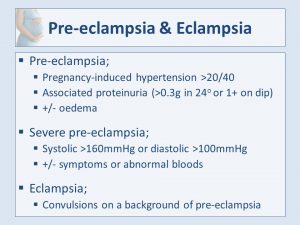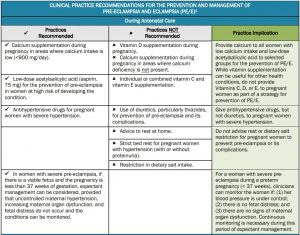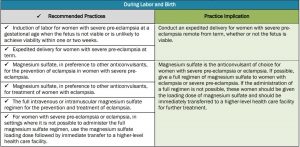
Table of Contents
What is Pre-eclampsia?
- Pre-eclampsia is a condition when a pregnant woman has high blood pressure and protein in urine.
- A complication during pregnancy characterized by high blood pressure that damages another organ system, especially the liver and kidneys.
- Pre-eclampsia normally begins after 20 weeks of pregnancy in women whose blood pressure was normal before pregnancy.
- Pre-eclampsia is similar to gestational hypertension.
- Pre-eclampsia is also a leading cause of pre-term birth.
- According to the World Health Organization, pre-eclampsia and eclampsia cause 14% of maternal deaths each year, or about 50,000 to 75,000 women worldwide.
What is Eclampsia?
- Eclampsia is a severe progression/complication of pre-eclampsia.
- Eclampsia is a rare but serious condition in which high blood pressure results in seizures or coma, usually in late pregnancy.
- If preeclampsia is severe enough to affect brain function, causing seizures or coma, it is called/known as eclampsia.
- It is a rare condition, affecting one in every 2000-3000 pregnancies every year.
- If pre-eclampsia is left untreated then it develops into eclampsia and creates additional problems during delivery or pregnancy.

Who are at Risk?
Women are regarded as being at high risk of developing pre-eclampsia if they have one or more of the following risk factors:
- Previous pre-eclampsia
- Diabetes
- Chronic hypertension
- Renal disease
- Autoimmune disease; and
- Multiple pregnancies.
Causes of Pre-eclampsia & Eclampsia:
The actual cause of pre-eclampsia/ eclampsia is still not clearly understood. However, according to experts, some of the causes of Pre-eclampsia and eclampsia are:
- Imperfect vascularization of the placenta
- Genetic factors
- Blood vessel problems
- Auto immune disorders
- Poor nutrition and high body fat
- Lack of blood flow to the uterus
Factors Contributing to Pre-eclampsia & Eclampsia:
- Family history of hypertension.
- Chronic hypertension
- Family history of diabetes mellitus
- In vitro fertilization
- Race
- Multiple pregnancies
- Interval between pregnancies
- Patient age
- Obesity
- Pregnancy history
- Renal disease
- Gestational diabetes
- Lupus
- Rheumatoid arthritis
- Carrying more than one baby
Risks Associated with Pre-eclampsia and Eclampsia:
Problems with pre-eclampsia and eclampsia pose risks to the fetus and mother such as:
- Lack of oxygen and nutrients, which can impair fetal growth
- Preterm birth
- Infants born preterm due to pre-eclampsia face a higher risk of some long-term health issues, mostly related to being born early, including learning disorders, cerebral palsy, epilepsy, deafness, and blindness.
- Infants born preterm may also have to be hospitalized for a long time after birth and may be smaller than infants born full term.
- Infants who experienced poor growth in the uterus may later be at higher risk of diabetes, congestive heart failure, and high blood pressure
- Stillbirth, if placental abruption (separation of the placenta from the uterine wall) leads to heavy bleeding in the mother.
- Stillbirths are more likely to occur when the mother has a more severe form of preeclampsia, including HELLP syndrome.
- Infant death
- Risk for damage to the kidneys, liver, brain, and other organ and blood systems.
- Organ failure or stroke
- In severe cases, pre-eclampsia can develop into eclampsia, which includes seizures. Seizures in eclampsia may cause a woman to lose consciousness. If the fetus is not delivered, these conditions can cause the death of the mother and/or the fetus.
Evidence-based Recommendations for Prevention/Treatment of Pre-eclampsia & Eclampsia:
World Health Organization highlights following evidence-based recommendations prevention and treatment of Pre-eclampsia and Eclampsia:
- Calcium supplementation during pregnancy to prevent pre-eclampsia and its complications (in areas where dietary calcium intake is low)
- Low-dose acetylsalicylic acid (aspirin, 75 mg/day) is recommended for the prevention of pre-eclampsia in women at high risk of developing the condition.
- Antihypertensive drugs for women with severe hypertension during pregnancy.
- Magnesium sulphate for prevention and treatment of eclampsia in women with severe pre-eclampsia.
- Induction of labor for women with severe pre-eclampsia.
- Policy of early delivery is recommended for women with severe pre-eclampsia at term.
- Prevention and treatment of postpartum hypertension through antihypertensive drugs (in women who were treated with antihypertensive drugs antenatally).
Source: (https://apps.who.int/iris/bitstream/handle/10665/44703/9789241548335_eng.pdf?sequence=1)



Additional Recommendation & Measures for Prevention & Treatment of Pre-eclampsia & Eclampsia:
- Calcium supplements, especially to women who have calcium deficiency before pregnancy. Supplements should also be given in areas where calcium intake is <900mg/day.
- Adequate parental care to recommend lots of water and fluid intake or reduction of salt intake.
- Special attention to high risk groups.
- Maintain normal body weight.
- No intake of medications, vitamins supplements without consulting to the doctor.
- Revise national guidelines and protocols according to evidence-based practices
- Adopt participatory processes to change health care providers behavior in align with the evidence-based practices.
Differences between Pre-Eclampsia and Eclampsia:
| Difference based on | Pre-eclampsia | Eclampsia |
| Process | High blood pressure and protein in the urine during pregnancy causes pre-eclampsia. | Eclampsia is more serious complications of pregnancy, comprised of repeated seizures, followed by exhausted state or in a coma state. |
| Criteria for diagnosis | Onset of a new episode of hypertension during pregnancy, characterized by:
• Persistent hypertension (diastolic blood pressure ≥ 90 mm Hg) and • Substantial proteinuria (> 0.3 g/24 hours). |
Generalized seizures, generally in addition to pre-eclampsia criteria. |
| Results | High blood pressure, increased albuminuria, persistent headache, edema, oliguria, fatigue, drowsiness and vomiting along with multiple symptoms. | High blood pressure results into pre-eclampsia, seizure in late pregnancy, conditions like edema, pulmonary edema, headache, and gestational diabetes. |
| Occurrence | Usually, pre-eclampsia occurs after 20 weeks pregnancy. | Usually, eclampsia occurs in the last trimester of pregnancy but might appear before, after or during pregnancy. |
| Signs and symptoms | May be asymptomatic but if symptoms are seen then, the noticeable ones are:
|
|
| Treatment | Take low-dose aspirin daily after 12 weeks of pregnancy | Full intravenous or intramuscular magnesium sulphate regimens/loading dose of magnesium sulphate
Delivery of the baby |
References and For More Information:
https://apps.who.int/iris/bitstream/handle/10665/119627/WHO_RHR_14.17_eng.pdf?sequence=1
https://apps.who.int/iris/bitstream/handle/10665/44703/9789241548335_eng.pdf?sequence=1
https://apps.who.int/iris/bitstream/handle/10665/70731/WHO_RHR_11.25_eng.pdf?sequence=1
https://apps.who.int/iris/bitstream/handle/10665/44145/9789241546669_2_eng.pdf?sequence=2
https://www.who.int/reproductivehealth/publications/maternal_perinatal_health/9789241548335/en/
https://www.mayoclinic.org/diseases-conditions/preeclampsia/symptoms-causes/syc-20355745
https://www.medicalnewstoday.com/articles/316255.php
https://bmcpregnancychildbirth.biomedcentral.com/articles/10.1186/s12884-015-0502-7
https://www.nichd.nih.gov/health/topics/preeclampsia/conditioninfo/risk-fetus
https://www.lorecentral.org/2017/09/differences-pre-eclampsia-eclampsia.html
https://www.carnegieimaging.com/blog/preeclampsia-eclampsia-understanding-difference/
https://www.webmd.com/baby/guide/preeclampsia-eclampsia#1
https://www.healthline.com/health/eclampsia#symptoms